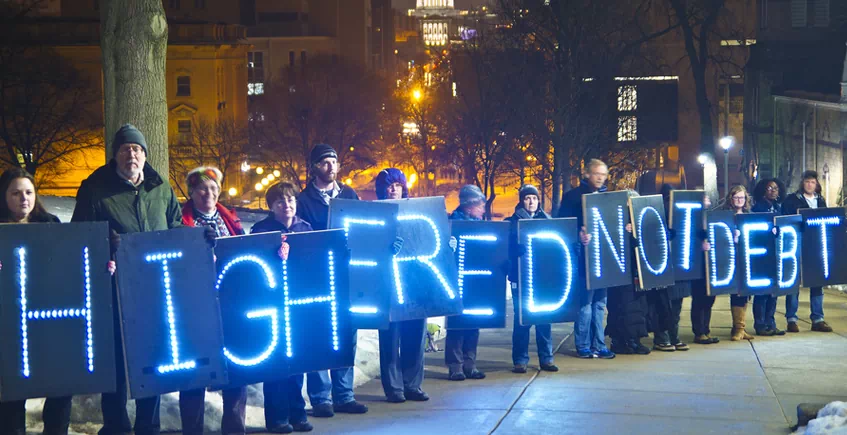Photo Courtesy: Light Brigading
The crisis of financial literacy continues to be of concern for students, parents and educators alike. Students are taking on more debt to help alleviate the rising cost of higher education. Student loan debt is now the second highest type of consumer debt in the US. Without the proper financial literacy education, student loans have the potential to be a disparaging burden on the US population. Low levels of financial literacy and a poor grasp of financial concepts lead to both student loan default and a decrease in student retention—a costly outcome for both students and institutions of higher education.
Fortunately, a number of colleges and universities around the country have embraced the fact that financial literacy education and awareness programs are a necessary tool for student success. In an effort to help thwart the student debt crisis spawn from financial illiteracy, some colleges and universities are taking unique steps to educate students about their finances. While some institutions are focused on assisting students with creating money management skills, other campuses are working toward educating students about effective financial behaviors and attitudes.
Here are five higher education institutions working to help eliminate the financial literacy crisis among the student population:
Western Governors University
As a leader in the non-profit, online university network, Western Governors University stands out as a proponent for financial literacy among its students. Instead of requiring students to rely on their minimal understanding of student debt, WGU has implemented a financial aid correspondence system that is both easy to comprehend and ultimately beneficial for students. Each student is provided with a suggested loan amount sufficient to cover tuition and fees for that year. The University takes into account any scholarships or grants students have received for that timeframe in the calculation, making it simple to determine true need as opposed to maximum loan amount available. While each student still has the opportunity take their maximum funding for the term, only 25% end up taking more than the suggested amount according to a WGU spokesperson. The launch of the University’s financial literacy initiative helped students reduce total borrowing by nearly $125 million since its launch in 2013 despite growth in enrollment.
Indiana University
Administrators and educators at Indiana University have been implementing financial literacy programs campus-wide since 2012. Similar to WGU, IU students receive a letter each year that details both federal and private student loans processed through the University, giving borrowers a clear picture of total balances and estimated payments due after graduation. In addition to this powerful insight into total borrowing, students are provided with the estimated interest rate of their loans, helping them understand the total cost of debt over time. Through the initiative, IU has been successful in lowering its student debt by $44 million over two years.
To ensure students are receiving the education component necessary to build a foundation for financial wellness, IU also launched MoneySmarts in early 2013. The online platform serves as the University’s portal for all financial literacy programs and includes primers on money management, budgeting, and various loan repayment options for borrowers,as well as podcasts on other relevant financial topics. Students also have the opportunity to take advantage of peer mentoring sessions and group presentations offered by undergraduate students at the University.
|
University of South Carolina Upstate
In partnership with SunTrust Bank, the University of South Carolina Upstate will begin offering a lunch and learn series to community members, staff, faculty and students on campus. Slated to launch in January of 2016, the five-week financial literacy class will cover a myriad of topics meant to build a greater understanding of financial concepts and practices, including insurance protection, individual investing, retirement and estate planning, and personal financing. USC Upstate will offer the financial literacy class for a small fee for community members, staff and faculty, but students are allowed to participate at no cost.
Community College of Baltimore County
For some students, the open-access system and lower-cost structure offered by a community college provides a greater chance for success in completing a college degree. However, community college students face financial challenges just the same as other students, and the need for financial literacy education abounds. The Community College of Baltimore County was recently awarded for its efforts in increasing student completion rates due, in part, to its implementation of financial literacy education courses. CCBC in partnership with OneMain Financial provides students an array of classes on money management, planning for the financial future and other practical habits related to financial literacy topics. In addition to its course offerings, CCBC also offers students the opportunity to engage with a financial coaching service shaped after advisor/client service models use by OneMain Financial. The financial literacy courses and financial coaching at CCBC reach more than 6,000 students each year.
University of Alabama at Birmingham
The Collat School of Business at the University of Alabama at Birmingham has taken impressive steps to ensure its students are on track for financial wellness during and after their time with the school. In 2013, the Board of Trustees for the University of Alabama system granted the Collat School of Business approval to establish the Institute for Financial Literacy. Under the initiative, the school plans to offer programs, materials, classes and counseling to community members, staff, faculty and students of UAB, all intended to enhance financial literacy on and off campus. In addition, the Institute for Financial Literacy will facilitate outreach services by way of special community events as well as teacher training seminars.











